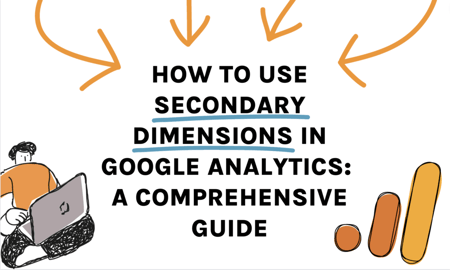Boost Your SEO Campaigns with Secondary Dimensions: A Comprehensive Overview
Boost Your SEO Campaigns with Secondary Dimensions: A Comprehensive Overview
Blog Article
Maximize Your Reporting Accuracy With Additional Measurements
Second measurements use a portal to augmenting reporting precision by supplying a diverse lens with which to check out data. As we begin on this journey of leveraging second measurements, the landscape of reporting accuracy beckons with promises of enhanced quality and calculated decision-making.
Relevance of Second Measurements
Utilizing second measurements is crucial for boosting the deepness and granularity of reporting understandings in information analysis. By incorporating secondary measurements right into data analysis procedures, organizations can get a much more detailed understanding of their performance metrics. These added measurements offer an even more thorough sight of the primary information, permitting a much more nuanced analysis of patterns and fads. Secondary dimensions enable analysts to sector and filter data based upon details criteria, providing an extra customized and targeted evaluation.
Furthermore, second measurements help in determining relationships and relationships that may not be quickly obvious when examining information with only primary dimensions. This much deeper degree of insight can cause even more informed decision-making and calculated preparation within an organization. By leveraging additional measurements effectively, companies can discover concealed opportunities, pinpoint areas for enhancement, and enhance their overall efficiency.
Executing Additional Measurements
To incorporate secondary measurements effectively right into information analysis procedures, companies need to embrace an organized strategy that lines up with their reporting purposes and analytical objectives. Executing secondary measurements includes choosing the best dimensions that provide deeper insights right into key information metrics.
In addition, businesses require to make certain that the selected additional dimensions are pertinent to the main information and give significant context without creating info overload. Applying additional measurements also needs specifying clear analytical inquiries that the additional dimensions will assist address. By structuring the execution procedure around these factors to consider, companies can make the most of the value derived from additional measurements and enhance the accuracy and deepness of their coverage.
Studying Data With Additional Measurements

One secret aspect of assessing information with secondary measurements is to make sure that the selected measurements line up with your particular logical objectives. Choosing the right additional dimensions can offer context and nuance to your main data metrics, allowing you to attract more precise conclusions and make informed decisions based upon the understandings obtained.
Moreover, leveraging second measurements properly can aid in recognizing outliers, recognizing the impact of various variables on your vital performance indications, and getting an extensive sight of your information landscape. By delving right into information with secondary dimensions, you can improve the deepness and high quality of your evaluation, resulting in even more robust reporting and workable outcomes.

Enhancing Insights Via Second Measurements
Checking out data with additional dimensions not just grows analysis but additionally amplifies the potential for uncovering important insights that can substantially improve reporting accuracy. By adding second measurements to your records, you can acquire a more thorough understanding of the connections between different information factors. This improved viewpoint enables you to identify patterns, patterns, and correlations that might have been neglected when analyzing information with primary measurements alone.

In essence, leveraging additional measurements empowers you to draw out richer understandings from your data, enabling you to make even more informed decisions and maximize your coverage accuracy.
Finest Practices for Second Dimensions
Using additional dimensions efficiently needs mindful consideration of essential methods to boost data analysis and reporting accuracy. When carrying out second dimensions, it is vital to straighten them with your key metrics to derive meaningful insights. One finest technique is to make use of second dimensions sparingly, concentrating on those that straight add to the specific analysis objectives. By staying clear of the lure to include excessive dimensions, you can preserve clearness in your reporting and stop info overload.
One more vital technique is to trying out various mixes of key and additional dimensions to uncover unique correlations and patterns within your information. This repetitive approach can disclose valuable insights that may have been overlooked or else. In addition, it is necessary to regularly review and improve your my website second dimension options to ensure they continue to be pertinent and lined up with your developing reporting needs.
Furthermore, recording the rationale behind your selection of second measurements can supply context for future analysis and facilitate partnership within your team. By following these ideal methods, you can make best use of the performance of additional measurements in boosting your reporting precision and driving notified decision-making.
Conclusion
Including secondary dimensions in data analysis is crucial for optimizing reporting precision and gaining deeper insights into performance trends. Executing finest techniques for second measurements enhances the depth of evaluation and improves the relevance of reporting outcomes.
Additionally, additional measurements assist in determining relationships and relationships that may not be promptly evident when analyzing data with only main dimensions. Executing additional dimensions includes picking the appropriate measurements that supply much click for info deeper understandings into primary data metrics. Carrying out second measurements additionally requires specifying clear logical inquiries that the additional measurements will certainly help answer.When evaluating information with secondary measurements, it is necessary to concentrate on drawing out beneficial understandings that enhance key information metrics. By integrating secondary dimensions into your evaluation, you can reveal patterns, fads, and connections that may not be apparent when looking at the data from a key measurement alone.
Report this page